Power System Event Ranking Using a New Linear Parameter-Varying Modeling with a Wide Area Measurement System-Based Approach
Abstract
:1. Introduction
- Considering not only steady-state response but also the dynamical behavior of the system after event occurrence.
- Using polytopic LPV modeling for covering the nonlinearity of the system in transient responses.
- Proposing some new and enhanced indices and comparing them using nonlinear simulations.
2. LPV Model for Power System Event Condition
3. The Proposed Indices for Event Ranking
3.1. Non-Linear TDS Based Ranking Index
3.2. Modal Based Event Ranking Index
3.3. FR Based Event Ranking Index
4. Simulation Results and Evaluation
4.1. Power System Representation
4.2. Nonlinear Simulation of Event Conditions
4.3. Linear Models of Power System for Event Conditions
4.4. Ranking Results
4.5. Discussion of Results
4.6. Ranking Evaluation in Different Conditions
5. Conclusions
Acknowledgments
Author Contributions
Conflicts of Interest
References
- Pandiarajan, K.; Babulal, C.K. Static security enhancement using fuzzy particle swarm optimization. COMPEL Int. J. Comput. Math. Electr. Electron. Eng. 2016, 35, 172–186. [Google Scholar] [CrossRef]
- El-Kady, M.A.; Alaskar, B.A.; Shaalan, A.M.; Al-Shammri, B.M. Composite Reliability and Quality Assessment of Interconnected Power Systems Interconnected Power Systems. COMPEL Int. J. Comput. Math. Electr. Electron. Eng. 2007, 26, 7–21. [Google Scholar] [CrossRef]
- Matos, M.A. Formal requirements for utility and value functions for security related decisions. COMPEL Int. J. Comput. Math. Electr. Electron. Eng. 2004, 23, 225–236. [Google Scholar] [CrossRef]
- EKWUE, A.O. A Voltage-Based Automatic Contingency Selection Algorithm Via A Linearization Method. COMPEL Int. J. Comput. Math. Electr. Electron. Eng. 1990, 9, 99–107. [Google Scholar] [CrossRef]
- Bharata Reddy, M.J.; Rajesh, D.V.; Mohanta, D.K. Robust transmission line fault classification using wavelet multi-resolution analysis q. Comput. Electr. Eng. 2013, 39, 1219–1247. [Google Scholar] [CrossRef]
- Ataei, M.; Hooshmand, R.-A.; Parastegari, M. A Wide Range Robust PSS Design Based on Power System Pole-Placement Using Linear Matrix Inequality. J. Electr. Eng. 2012, 63, 233–241. [Google Scholar] [CrossRef]
- Da Silva, E.F.; Rahmani, M.; Rider, M.J. A Search Space Reduction Strategy and a Mathematical Model for Multistage Transmission Expansion Planning with N-1 Security Constrains. J. Control. Autom. Electr. Syst. 2014, 26, 57–67. [Google Scholar] [CrossRef]
- Ritonja, J.; Dolinar, D.; Polajžer, B. Adaptive and robust controls for static excitation systems. COMPEL Int. J. Comput. Math. Electr. Electron. Eng. 2015, 34, 864–881. [Google Scholar] [CrossRef]
- Ciapessoni, E.; Cirio, D.; Massucco, S.; Morini, A.; Pitto, A.; Silvestro, F. Risk-Based Dynamic Security Assessment for Power System Operation and Operational Planning. Energies 2017, 10, 475. [Google Scholar] [CrossRef]
- Tang, L. Dynamic Security Assessment Processing System. Ph.D. Thesis, Iowa State University, Ames, IA, USA, 2014. [Google Scholar]
- Baone, C.A.; Acharya, N.; Veda, S.; Chaudhuri, N.R. Fast contingency screening and ranking for small signal stability assessment. In Proceedings of the 2014 IEEE PES General Meeting|Conference & Exposition, National Harbor, MD, USA, 27–31 July 2014; pp. 1–5. [Google Scholar]
- Arrieta, R.; Rios, M.A.; Torres, A. Contingency Analysis and Risk Assessment of Small Signal Instability. In Proceedings of the 2007 IEEE Lausanne Power Tech, Lausanne, Switzerland, 1–5 July 2007; pp. 1741–1746. [Google Scholar]
- Sevilla, F.R.S.; Vanfretti, L. A small-signal stability index for power system dynamic impact assessment using time-domain simulations. In Proceedings of the 2014 IEEE PES General Meeting|Conference & Exposition, National Harbor, MD, USA, 27–31 July 2014; pp. 1–5. [Google Scholar]
- Yeu, R.H. Small Signal Analysis of Power Systems: Eigenvalue Tracking Method and Eigenvalueestimation Contingency for DSA; Illinois at Urbana-Champaign: Urbana, IL, USA, 2010. [Google Scholar]
- Rueda, L.; Cepeda, J.C.; Korai, A.W.; Gonzalez-longatt, F.M. PowerFactory Applications for Power System Analysis; Springer: Berlin/Heidelberg, Germany, 2014; pp. 249–266. [Google Scholar]
- Ashok, A.; Hahn, A.; Govindarasu, M. Cyber-physical security of Wide-Area Monitoring, Protection and Control in a smart grid environment. J. Adv. Res. 2014, 5, 481–489. [Google Scholar] [CrossRef] [PubMed]
- Hong, S.; Cheng, H.; Zeng, P. An N-k Analytic Method of Composite Generation and Transmission with Interval Load. Energies 2017, 10, 168. [Google Scholar] [CrossRef]
- Jia, Y.; Meng, K.; Xu, Z. N-k Induced Cascading Contingency Screening. IEEE Trans. Power Syst. 2015, 30, 2824–2825. [Google Scholar] [CrossRef]
- Patterson, S.A.; Apostolakis, G.E. Identification of critical locations across multiple infrastructures for terrorist actions. Reliab. Eng. Syst. Saf. 2007, 92, 1183–1203. [Google Scholar] [CrossRef]
- Sandy Diaz, R.; Domingos, A.C.J.; Vazquez Silva, E. An algorithm to verify asymptotic stability conditions of a certain family of systems of differential equations. Appl. Math. Sci. 2014, 8, 1509–1520. [Google Scholar]
- Xiang, W.; Xiao, J. Finite-time stability and stabilisation for switched linear systems. Int. J. Syst. Sci. 2013, 44, 384–400. [Google Scholar] [CrossRef]
- Xiong, J.; Lam, J.; Shu, Z.; Mao, X. Stability Analysis of Continuous-Time Switched Systems with a Random Switching Signal. IEEE Trans. Autom. Contr. 2014, 59, 180–186. [Google Scholar] [CrossRef] [Green Version]
- She, Z.; Xue, B. Discovering multiple Lyapunov functions for switched hybrid systems. SIAM J. Control Optim. 2014, 52, 3312–3340. [Google Scholar] [CrossRef]
- De Souza, W.A.; Teixeira, M.C.M.; Santim, M.P.A.; Cardim, R.; Assuncao, E. On switched control design of linear time-invariant systems with polytopic uncertainties. Math. Probl. Eng. 2013, 2013, 595029. [Google Scholar] [CrossRef]
- Jabali, M.B.A.; Kazemi, M.H. A new LPV modeling approach using PCA-based parameter set mapping to design a PSS. J. Adv. Res. 2017, 8, 23–32. [Google Scholar] [CrossRef] [PubMed]
- Shamma, J.S. An overview of LPV systems. In Control of Linear Parameter Varying Systems with Applications; Mohammadpour, J., Scherer, C.W., Eds.; Springer: New York, NY, USA, 2012; pp. 3–26. [Google Scholar]
- Ma, J.; Wang, T.; Thorp, J.S.; Wang, Z.; Yang, Q.; Phadke, A.G. WAMS based damping control of inter-area oscillations employing energy storage system. Adv. Electr. Comput. Eng. 2012, 12, 33–40. [Google Scholar] [CrossRef]
- Khaji, M.; Aghamohammadi, M.R. Online emergency damping controller to suppress power system inter-area oscillation using load-generation tripping. Electr. Power Syst. Res. 2016, 140, 806–820. [Google Scholar] [CrossRef]
- Wang, C.; Zhang, Y. Fault Correspondence Analysis in Complex Electric Power Systems. Adv. Electr. Comput. Eng. 2015, 15, 11–16. [Google Scholar] [CrossRef]
- Zhao, Y.M.; Xie, W.F.; Tu, X.W. Performance-based parameter tuning method of model-driven PID control systems. ISA Trans. 2012, 51, 393–399. [Google Scholar] [CrossRef] [PubMed]
- Panda, S.; Padhy, N.P. Thyristor Controlled Series Compensator-based Controller Design Employing Genetic Algorithm: A Comparative Study. Int. J. Electron. Circuits Syst. 2007, 1, 38–47. [Google Scholar]
- Banaei, M.R.; Toloue, H.; Kazemi, F.M.; Oskuee, M.R.J. Damping of power system oscillations using imperialist competition algorithm in power system equipped by HVDC. Ain Shams Eng. J. 2015, 6, 75–84. [Google Scholar] [CrossRef]
- Agnihotri, S.P.; Waghmare, L.M. Regression model for tuning the PID controller with fractional order time delay system. Ain Shams Eng. J. 2014, 5, 1071–1081. [Google Scholar] [CrossRef]
- Safari, A.; Soulat, B.; Ajami, A. Modeling and unified tuning of distributed power flow controller for damping of power system oscillations. Ain Shams Eng. J. 2013, 4, 775–782. [Google Scholar] [CrossRef]
- Sahu, R.K.; Chandra Sekhar, G.T.; Panda, S. DE optimized fuzzy PID controller with derivative filter for LFC of multi source power system in deregulated environment. Ain Shams Eng. J. 2015, 6, 511–530. [Google Scholar] [CrossRef]
- Kundur, P. Power System Stability and Control; McGraw-Hill: New York, NY, USA, 1994. [Google Scholar]
- DIgSILENT GmbH. Nine-Bus System Documentation 2014. Available online: http://digsilent.de/index.php/downloads.html (accessed on 26 July 2017).
- Anderson, P.M.; Fouad, A.A. Power System Control and Stability; The Iowa State University Press: Ames, IA, USA, 1977. [Google Scholar]
- Wazen, R.N.; Fernandes, T.S.P.; Aoki, A.R.; De Souza, W.E. Evaluation of the susceptibility of failures in steel structures of transmission lines. J. Control. Autom. Electr. Syst. 2013, 24, 174–186. [Google Scholar] [CrossRef]
- Huang, T.; Voronca, S.L.; Purcarea, A.A.; Estebsari, A.; Bompard, E. Analysis of chain of events in major historic power outages. Adv. Electr. Comput. Eng. 2014, 14, 63–70. [Google Scholar] [CrossRef]
- Chen, J.; Thorp, J.S.; Dobson, I. Cascading dynamics and mitigation assessment in power system disturbances via a hidden failure model. Int. J. Electr. Power Energy Syst. 2005, 27, 318–326. [Google Scholar] [CrossRef]
- Yu, X.; Singh, C. Probabilistic power system security analysis considering protection failures. COMPEL Int. J. Comput. Math. Electr. Electron. Eng. 2004, 23, 35–47. [Google Scholar] [CrossRef]
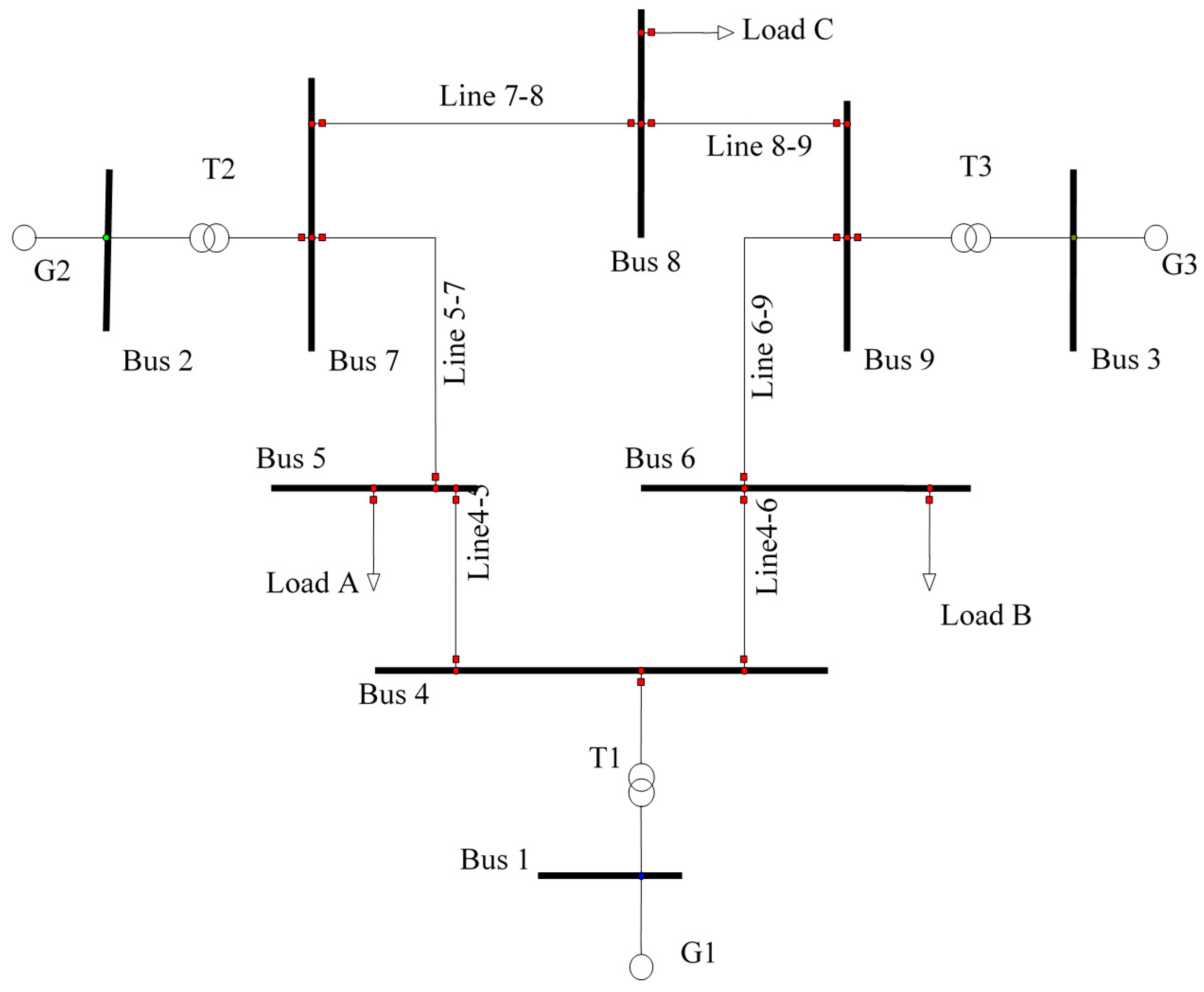
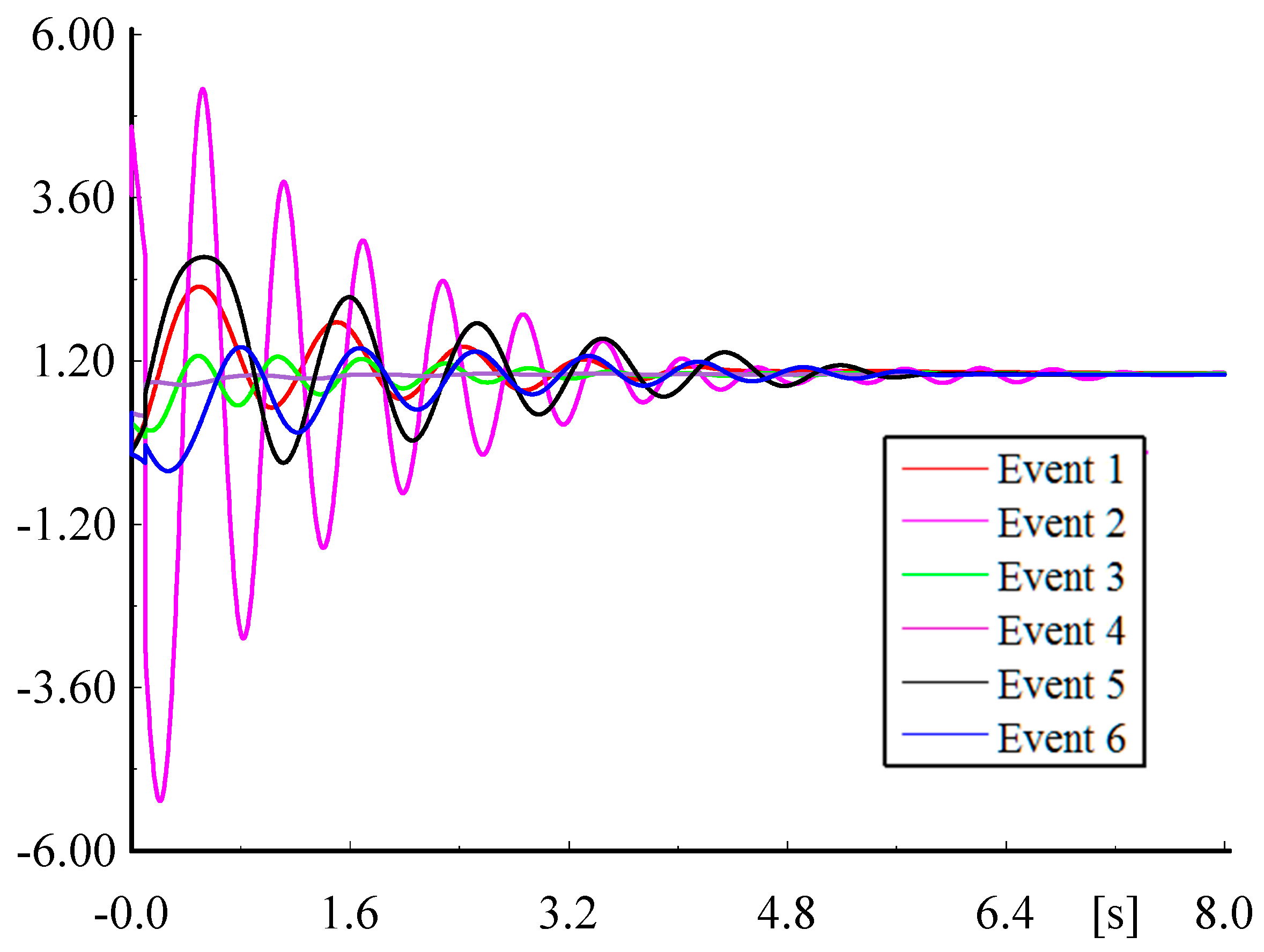
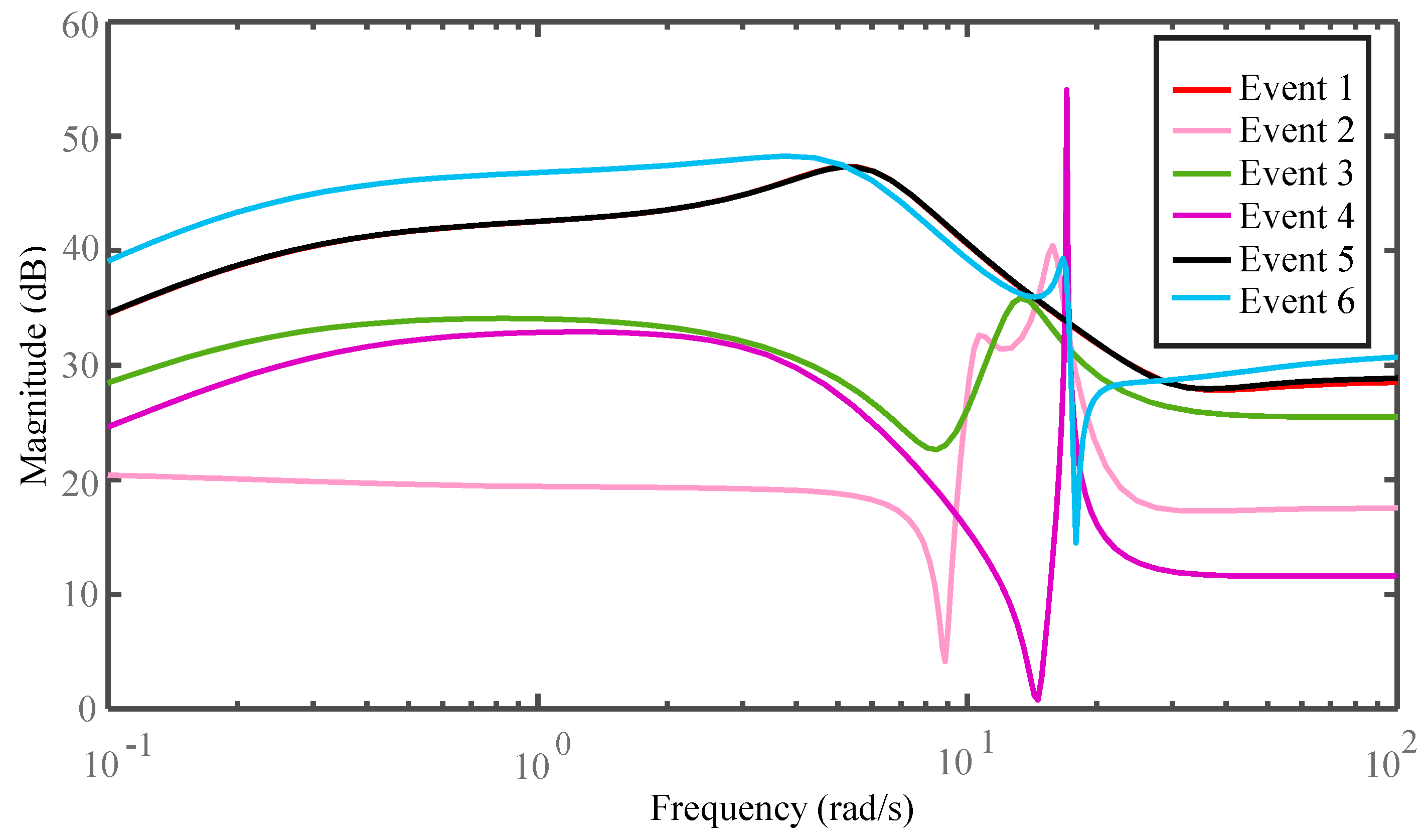
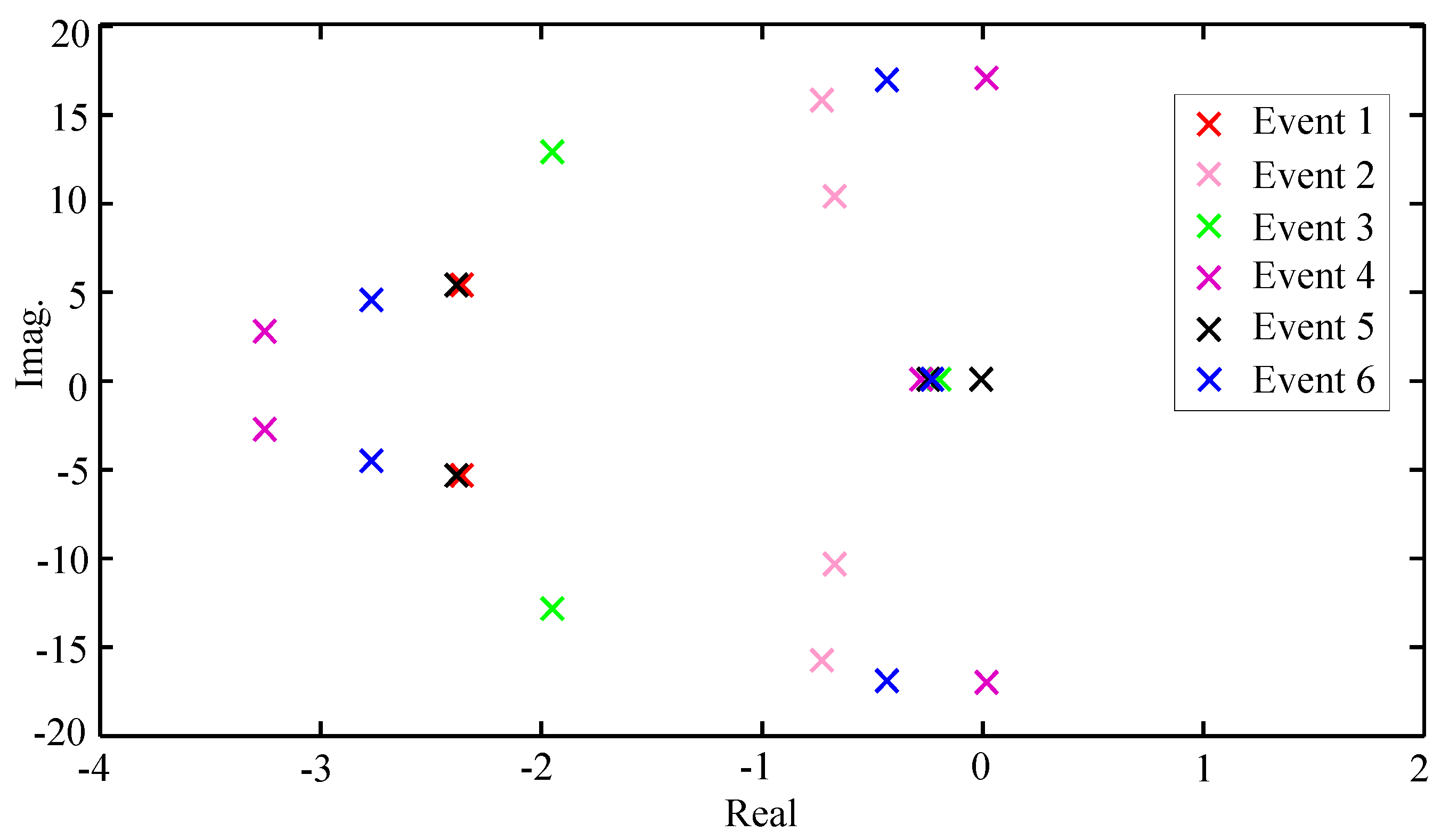
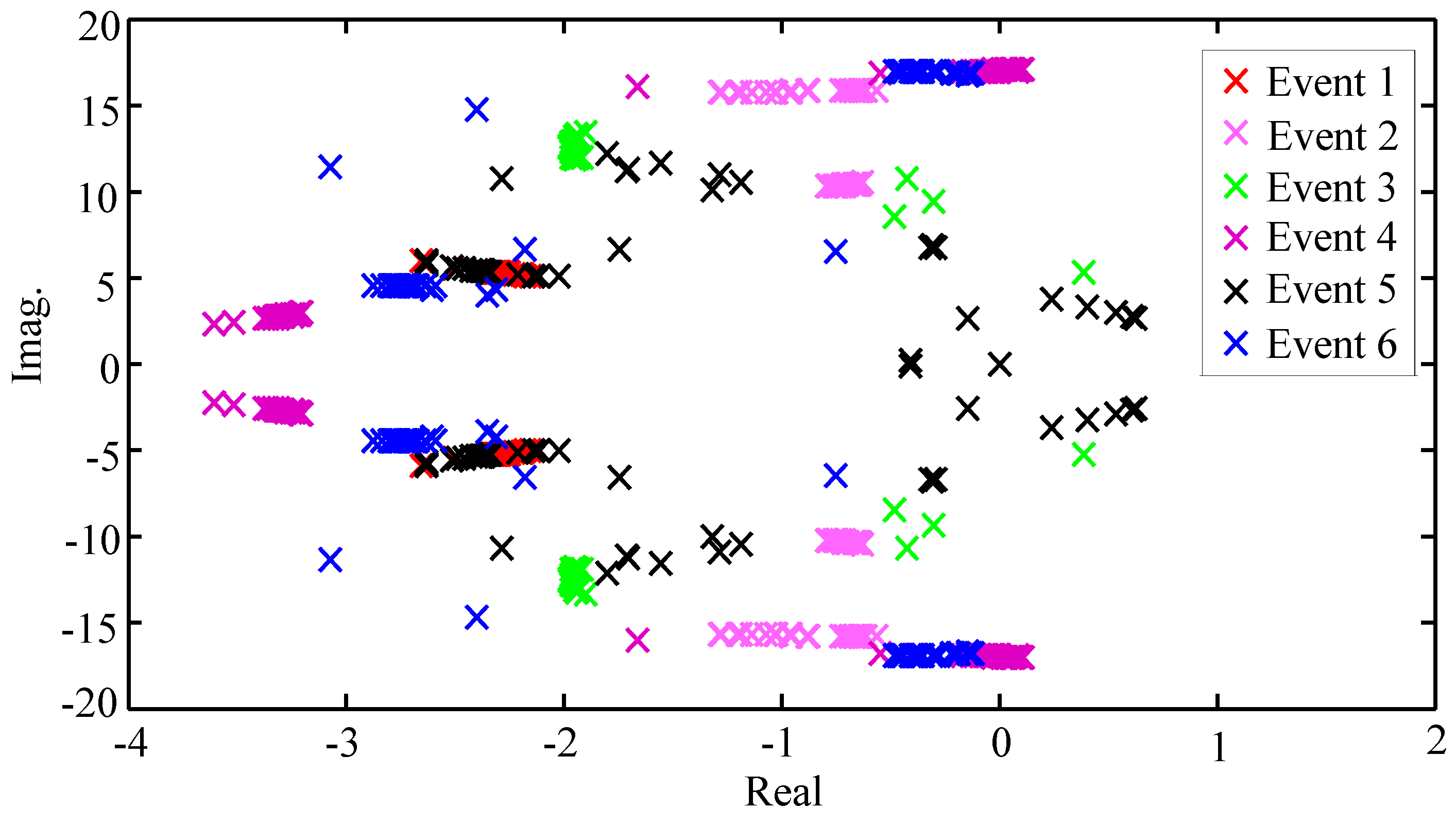
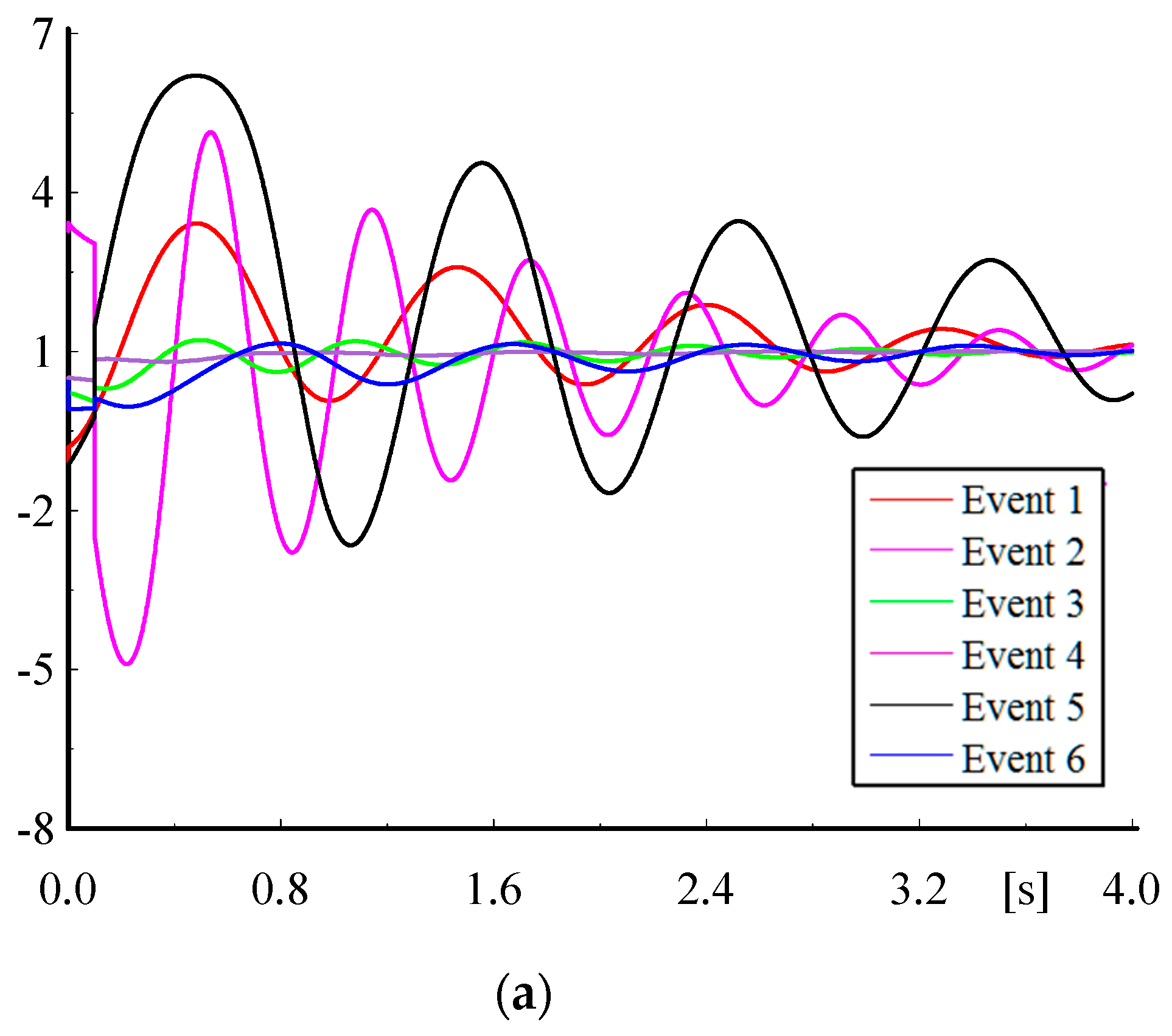
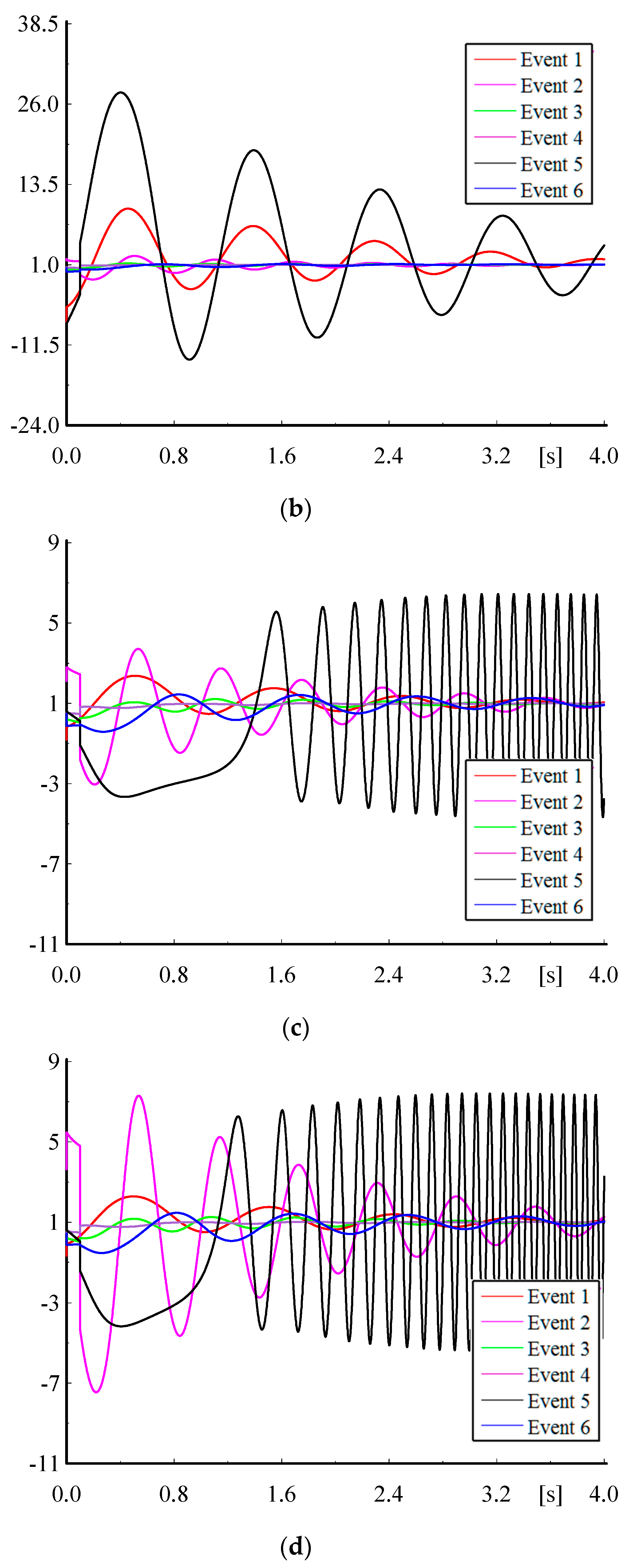
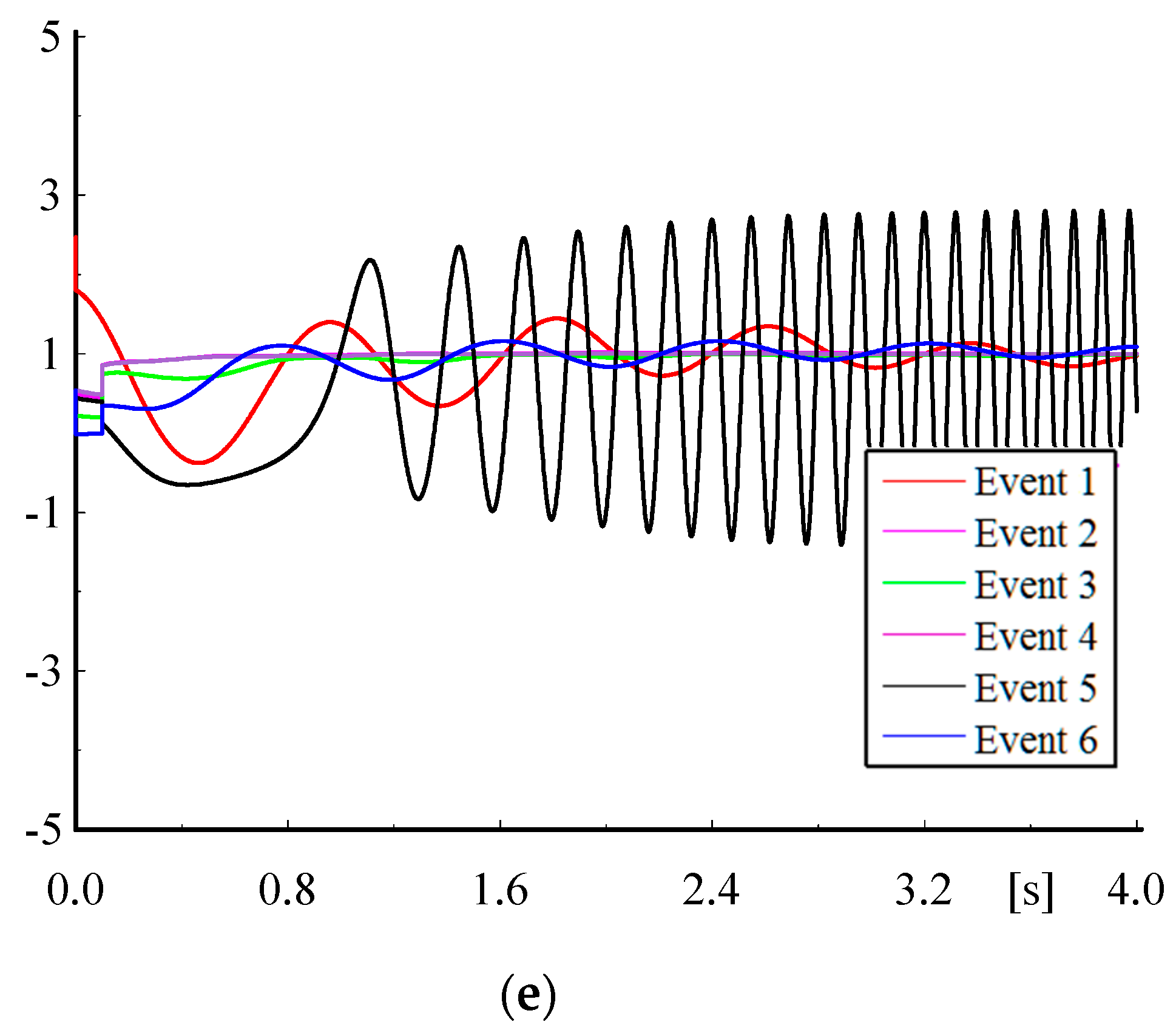
| Event Number | Description | |
|---|---|---|
| Affected Line | Fault | |
| 1 | Line 5–7 | - |
| 2 | Line 8–9 | 3ph-SHC |
| 3 | Line 7–8 | 3ph-SHC |
| 4 | Line 6–9 | 3ph-SHC |
| 5 | Line 5–7 | 3ph-SHC |
| 6 | Line 4–5 | 3ph-SHC |
| Rank | Event No. | NTDSITAE | Event No. | MP | Event No. | FREAE |
|---|---|---|---|---|---|---|
| 1 | 2 | 7.89 | 2 | 21.43 | 5 | 88.11 |
| 2 | 5 | 5.03 | 3 | 21.19 | 6 | 74.06 |
| 3 | 6 | 2.49 | 5 | 15.48 | 1 | 72.73 |
| 4 | 1 | 2.27 | 1 | 14.29 | 3 | 72.49 |
| 5 | 3 | 0.88 | 4 | 14.29 | 2 | 72.41 |
| 6 | 4 | 0.14 | 6 | 14.05 | 4 | 70.69 |
| Scenario Number | System Generation | System Loads | ||||
|---|---|---|---|---|---|---|
| G1 | G2 | G3 | LoadA | LoadB | LoadC | |
| 1 | 99 + j34 | 159 + j34 | 93 + j24 | 131 + j64 | 99 + j48 | 115 + j56 |
| 2 | 110 + j33 | 139 + j38 | 70 + j22 | 125 + j68 | 90 + j51 | 100 + j59 |
| 3 | 70 + j19 | 161 + j11 | 74 − j6 | 116 + j47 | 86 + j29 | 97 + j34 |
| 4 | 71 + j27 | 163 + j7 | 85 − j11 | 125 + j50 | 90 + j30 | 100 + j35 |
| 5 | 155 + j20 | 163 − j15 | 0 | 125 + j36 | 90 + j26 | 100 + j29 |
© 2017 by the authors. Licensee MDPI, Basel, Switzerland. This article is an open access article distributed under the terms and conditions of the Creative Commons Attribution (CC BY) license (http://creativecommons.org/licenses/by/4.0/).
Share and Cite
Abolhasani Jabali, M.B.; Kazemi, M.H. Power System Event Ranking Using a New Linear Parameter-Varying Modeling with a Wide Area Measurement System-Based Approach. Energies 2017, 10, 1088. https://doi.org/10.3390/en10081088
Abolhasani Jabali MB, Kazemi MH. Power System Event Ranking Using a New Linear Parameter-Varying Modeling with a Wide Area Measurement System-Based Approach. Energies. 2017; 10(8):1088. https://doi.org/10.3390/en10081088
Chicago/Turabian StyleAbolhasani Jabali, Mohammad Bagher, and Mohammad Hosein Kazemi. 2017. "Power System Event Ranking Using a New Linear Parameter-Varying Modeling with a Wide Area Measurement System-Based Approach" Energies 10, no. 8: 1088. https://doi.org/10.3390/en10081088





